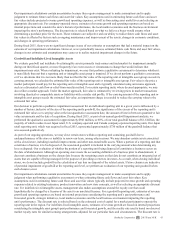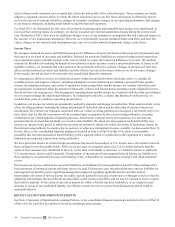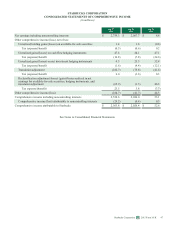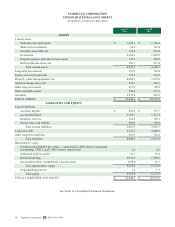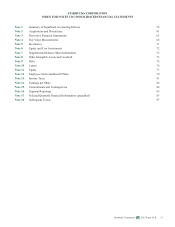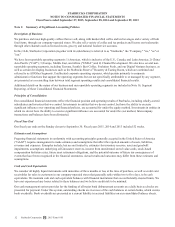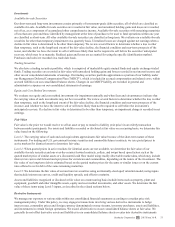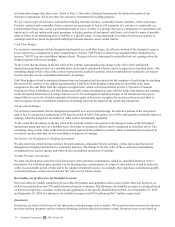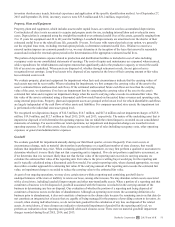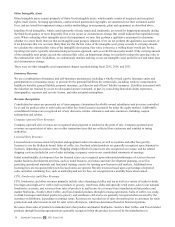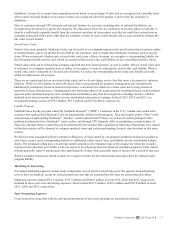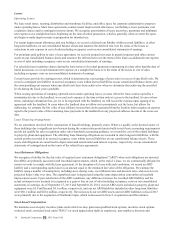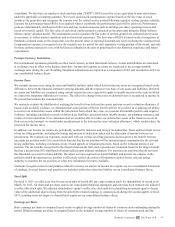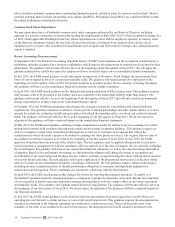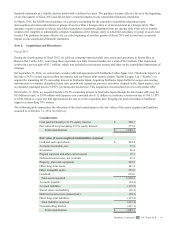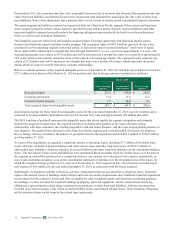Starbucks 2015 Annual Report Download - page 57
Download and view the complete annual report
Please find page 57 of the 2015 Starbucks annual report below. You can navigate through the pages in the report by either clicking on the pages listed below, or by using the keyword search tool below to find specific information within the annual report.
Investments
Available-for-sale Securities
Our short-term and long-term investments consist primarily of investment-grade debt securities, all of which are classified as
available-for-sale. Available-for-sale securities are recorded at fair value, and unrealized holding gains and losses are recorded,
net of tax, as a component of accumulated other comprehensive income. Available-for-sale securities with remaining maturities
of less than one year and those identified by management at the time of purchase to be used to fund operations within one year
are classified as short-term. All other available-for-sale securities are classified as long-term. We evaluate our available-for-sale
securities for other than temporary impairment on a quarterly basis. Unrealized losses are charged against net earnings when a
decline in fair value is determined to be other than temporary. We review several factors to determine whether a loss is other
than temporary, such as the length and extent of the fair value decline, the financial condition and near-term prospects of the
issuer, and whether we have the intent to sell or will more likely than not be required to sell before the securities' anticipated
recovery, which may be at maturity. Realized gains and losses are accounted for using the specific identification method.
Purchases and sales are recorded on a trade date basis.
Trading Securities
We also have a trading securities portfolio, which is comprised of marketable equity mutual funds and equity exchange-traded
funds. Trading securities are recorded at fair value with unrealized holding gains and losses recorded in net interest income and
other on our consolidated statements of earnings. Our trading securities portfolio approximates a portion of our liability under
our Management Deferred Compensation Plan ("MDCP"), which is included in accrued compensation and related costs, within
accrued liabilities on our consolidated balance sheets. Changes in our MDCP liability are recorded in general and
administrative expenses on our consolidated statements of earnings.
Equity and Cost Method Investments
We evaluate our equity and cost method investments for impairment annually and when facts and circumstances indicate that
the carrying value of such investments may not be recoverable. We review several factors to determine whether the loss is other
than temporary, such as the length and extent of the fair value decline, the financial condition and near-term prospects of the
investee, and whether we have the intent to sell or will more likely than not be required to sell before the investment’s
anticipated recovery. If a decline in fair value is determined to be other than temporary, an impairment charge is recorded in net
earnings.
Fair Value
Fair value is the price we would receive to sell an asset or pay to transfer a liability (exit price) in an orderly transaction
between market participants. For assets and liabilities recorded or disclosed at fair value on a recurring basis, we determine fair
value based on the following:
Level 1: The carrying value of cash and cash equivalents approximates fair value because of the short-term nature of these
instruments. For trading and U.S. government treasury securities and commodity futures contracts, we use quoted prices in
active markets for identical assets to determine fair value.
Level 2: When quoted prices in active markets for identical assets are not available, we determine the fair value of our
available-for-sale securities and our over-the-counter forward contracts, collars, and swaps based upon factors such as the
quoted market price of similar assets or a discounted cash flow model using readily observable market data, which may include
interest rate curves and forward and spot prices for currencies and commodities, depending on the nature of the investment. The
fair value of our long-term debt is estimated based on the quoted market prices for the same or similar issues or on the current
rates offered to us for debt of the same remaining maturities.
Level 3: We determine the fair value of our auction rate securities using an internally-developed valuation model, using inputs
that include interest rate curves, credit and liquidity spreads, and effective maturity.
Assets and liabilities recognized or disclosed at fair value on a nonrecurring basis include items such as property, plant and
equipment, goodwill and other intangible assets, equity and cost method investments, and other assets. We determine the fair
value of these items using Level 3 inputs, as described in the related sections below.
Derivative Instruments
We manage our exposure to various risks within our consolidated financial statements according to a market price risk
management policy. Under this policy, we may engage in transactions involving various derivative instruments to hedge
interest rates, commodity prices and foreign currency denominated revenue streams, inventory purchases, assets and liabilities,
and investments in certain foreign operations. We record all derivatives on our consolidated balance sheets at fair value. We
generally do not offset derivative assets and liabilities in our consolidated balance sheets or enter into derivative instruments
Starbucks Corporation 2015 Form 10-K 53


